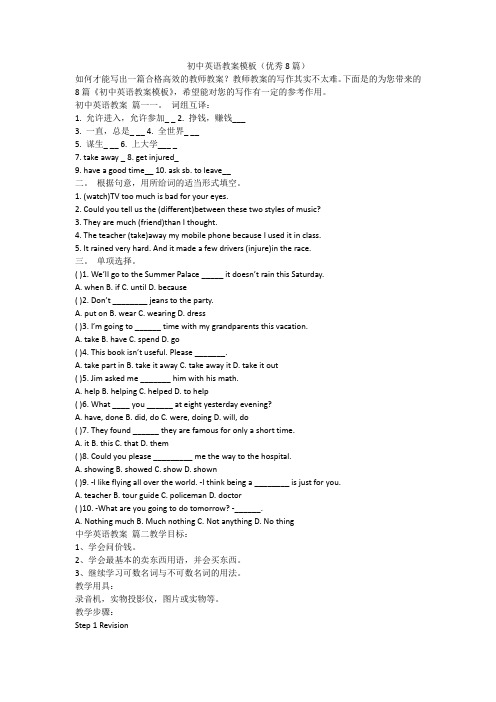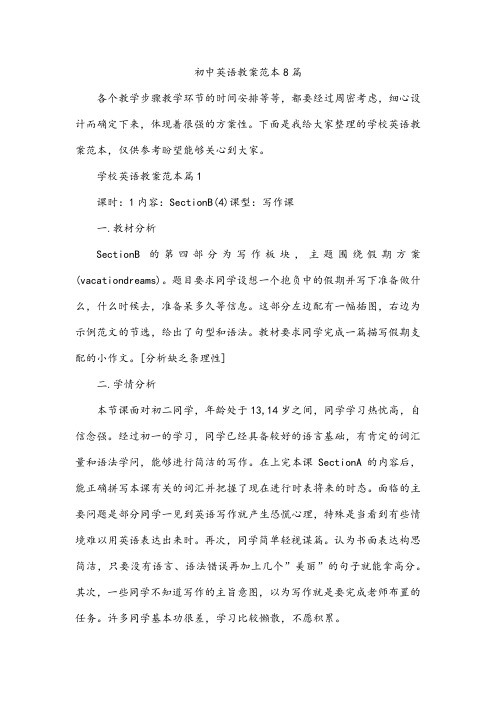初一英语教案模板范文
初一英语教案模板5篇

初一英语教案模板5篇初一英语教案模板5篇一篇好的英语教案,对于英语课程的教学而言有着十分重要的作用。
那么初一英语教案模板有哪些呢?下面是小编给大家整理的初一英语教案模板,希望大家喜欢!初一英语教案模板篇1一、教材分析本模块题材为童话故事,主要是关于Goldilocks的故事,另外增加了精卫填海的故事。
内容和情节很容易引发学生的兴趣,语言简单易懂,描写细致生动,非常有利于开展听、说、读、写方面的语言实践活动,让学生在使用语言的过程中学习语言,促使学生更有意识地自觉学习英语。
讲故事须使用一般过去时,所以本模块继续以一般过去时作为语法学习重点。
通过操练、使学生在掌握语言结构的同时、既学习语言知识、感悟语言功能、又能欣赏到美丽的童话故事,并能学会描述一个完整的故事或一件事情二、教学目标1.知识目标:语音:规则动词的一般过去时的发音词汇:once、hear、begin、decide、ride、golden、little、pick、notice、hurry、knock、nobody、push、open、enter、count、bowl、all、hungry、rush、try、destroy、unhappy、asleep、return、cry、point、without、die、emperor、onceuponatime、goforaride、pickup、lookaround、changeinto语法:规则动词的一般过去式。
功能:按时间顺序描述事情。
话题:以“童话故事”(fairytales)为话题。
2.能力目标:听:能听懂简单故事中的主要人和事。
说:运用一般过去时表述事件,讲简单的故事。
读:能读懂简单的故事,明白主要的人物、事件以及情节。
进行简单的技能训练。
写:运用一般过去时写简单的事情。
3.情感目标:通过阅读童话故事提高对英语的学习兴趣、感受学习的乐趣。
三、学习策略、文化意识1.学习策略:形成自主学习、有效交际、信息处理、英语思维能力。
七年级英语优秀教学设计(通用8篇)

七年级英语优秀教学设计(通用8篇)七年级英语优秀教学设计(通用8篇)作为一位兢兢业业的人民教师,常常要写一份优秀的教学设计,教学设计是把教学原理转化为教学材料和教学活动的计划。
我们应该怎么写教学设计呢?以下是小编精心整理的七年级英语优秀教学设计,仅供参考,大家一起来看看吧。
七年级英语优秀教学设计篇1Unit3. Why do yu like koalas?The first periodⅠ.Teaching Aims and Demands1.Knowledge Objects.1)Key vocabularykoala tiger elephent.dolphin panda lion penguin giraffe zoo cute map smart2)Target languageLet’s see the pandas.Why do you like see the tigers?Because they are cute.2.Ability Objects:1)Train students’abilities of listening and speakng.2) Enable and help the students to learn how to listen to and talk about animals.3.Moral Object:It is very important for everyone to love the nature and protect animals .The earth is our home and animals are our friends..It is our duty to love the nature and protect enviroment.Ⅱ Teaching Key and Difficult Points1)Describe the animals using the words and the target language.2)Get students to learn “Why questions”, “Because answers” a nd the adjectives of quality.Ⅲ.Teaching methods1)Watching and describing methods2) Oral practicing method.Ⅳ.Teaching Aids:1)objects and some pictures.2)A recorder and computerⅤ.Teaching proceduresStep1.Warming up1) Play the tape,get the students to listen to music of animals2) Play a guessing game.T: Listening to the voices of animals.What kinds of animals are they?3) Show some pictures about animals after guessing and talk about animals.T: Look,there is a big zoo in our city There are many animals init.Do you want to see the animals in the zoo?Let’s go into thezoo.What kind of animals can you see?Step2.Present the new words1) T: Look. What is this in Chinese?Ss:“考拉”T: What is this in English?Do you know?Ss: NoT: It is a koala. Read after me K-O-A-L A, koala.2)Show some new words in the pictures.and teach students to learn them.:koala tiger elephent.dolphin panda lion penguin giraffezoo cute map smartStep3. Practice the new words(1a)1)Get students to read the words in 1a2)Match the words with the animals in the oictures.3)After that check the answers.Step4. Task1) Look at the pictures of animals and describe the animals like this. T: Let’s see the pandas .Do you like them?S1: Yes.I like them very much.T: Why do you like them?S1: Because they are cute .Let’s see the lions.T: Why do you want to see the lions.?S1: Because they are smart.T: Do they live on the land or in the water?S1: They live on the land.(At the same time,Teach the students the words,smart,cute)2)Get students to come up wth more new adjectives of quality to describe the animals.cute, smart, fun, interesting, scary, shy, lazy.(At this time,we can also let the students have a competition.This method can make the students active in class and it can help them develop their quick response and wide thinking)3)Get students to ask and answer in pairs to descibe the animals.4)Get students to performin in front of the class.Step5. Listening1)Play the tape,get students to listen and check.the animals in 12)Play the tape again.Ask students to work in pairs.Studentslisten and repeat after the recording3)Check the answer.Step6. Pairwork1)Ask the students to make conversations in pairs. Show the followng.A:Let’s see the elephant.B:Why do you want to see the elephant?A:Because they are very smart.(T:Now please make conversations in pairs ,using the animals in Activity 1c.You can have a competition and let’s see which pair of students is the best?)2)Get a few pairs to show their conversations.Step7 SummaryToday we have learnt lots of new words of animals,and the target language.We can describe the animals and other things using the target language.Now,We should remember the earth is our home and animals are our friends. It is our duty to protect animals and love the nature. Step8 Homework.1)Make a survey:What animals do you like?why?2)Write them down and make a conversationVI Blackboard design七年级英语优秀教学设计篇2一、教学目标:1. 语言知识目标:1) 能掌握以下单词:guitar, sing, swim, dance, chess, play chess, draw, speak, speak English, join, club能掌握以下句型:① —Can you play the guitar? —Yes, I can./ No, I can't.② —What can you do? —I can dance.③ —What club do you want to join? —I want to join the chess club.2) 能了解以下语法:情态动词can的用法want to do sth.的用法2. 情感态度价值观目标:该部分内容贴近学生的生活,谈论的话题是能力。
初一英语教案模板范文5篇

初一英语教案模板范文5篇初一英语教案模板范文5篇写教案不能千篇一律,要发挥每一个老师的聪明才智和创造力,老师的教案要结合本地区的特点,因材施教。
老师要根据学生特性进行教学研究、教学交流和教学探讨。
以下是带来的初一英语教案模板范文内容,感谢您的阅读,希望能帮助到您!初一英语教案模板范文1一、Teaching Demands and Aims(教学目标)二、Teaching important and difficult point (教学重点)1、words2、sentences3、grammars三、Teaching Aids (教具)四、Teaching procedures(教学过程) Greeting(问候) warm up(热身) Review(复习) NewLeon(新课) Step One: Step Two: Step Three: Follow up(叮咛)五、Homework(作业布置)作业的布置一、书面作业1、每节课后教师可适当选择课后习题(书本或课外参考书)及字母作业。
2、低年纪的孩子适合听磁带读课文、画图、连线、写字母等简单作业;每学期两次测试:半期考和期末考试。
3、高年纪的孩子要求抄单词、背单词、背课文等书面作业;每节课前可做适当的听写练习;每个月可做适当的单元测试;期间两次大考:半期考和期末考。
二、磁带作业1、适时布置(条件允许可每周一次):将本周学习的内容录进磁带,下周上交。
2、录制要求:首先让学生和老师打招呼,接着报朗诵单元,然后录作业内容,最后与老师说再见。
(如:Hello! Amanda.I am Gogo.This is Unit 11……… Goodbye! Amanda!)3、听音修正:(1)书面记录:边听边把学生的错音登记在学生手册上。
(2)修正过程:A:打招呼,先表扬肯定,后提出错误,注意错音的跟读B:说悄悄话,增进师生感情交流C:提出问题。
D:结束Say:“ Good bye! ”三、电话教学1、时间安排:每月两次的电话教学,每生教学时间不超过8分钟。
初中英语教案模板(优秀8篇)

初中英语教案模板(优秀8篇)如何才能写出一篇合格高效的教师教案?教师教案的写作其实不太难。
下面是的为您带来的8篇《初中英语教案模板》,希望能对您的写作有一定的参考作用。
初中英语教案篇一一。
词组互译:1. 允许进入,允许参加_ _2. 挣钱,赚钱___3. 一直,总是_ __4. 全世界_ __5. 谋生_ __6. 上大学___ _7. take away _ 8. get injured_9. have a good time__ 10. ask sb. to leave__二。
根据句意,用所给词的适当形式填空。
1. (watch)TV too much is bad for your eyes.2. Could you tell us the (different)between these two styles of music?3. They are much (friend)than I thought.4. The teacher (take)away my mobile phone because I used it in class.5. It rained very hard. And it made a few drivers (injure)in the race.三。
单项选择。
( )1. We’ll go to the Summer Palace _____ it doesn’t rain this Saturday.A. whenB. ifC. untilD. because( )2. Don’t ________ jeans to the party.A. put onB. wearC. wearingD. dress( )3. I’m going to ______ time with my grandparents this vacation.A. takeB. haveC. spendD. go( )4. This book isn’t useful. Please _______.A. take part inB. take it awayC. take away itD. take it out( )5. Jim asked me _______ him with his math.A. helpB. helpingC. helpedD. to help( )6. What ____ you ______ at eight yesterday evening?A. have, doneB. did, doC. were, doingD. will, do( )7. They found ______ they are famous for only a short time.A. itB. thisC. thatD. them( )8. Could you please _________ me the way to the hospital.A. showingB. showedC. showD. shown( )9. -I like flying all over the world. -I think being a ________ is just for you.A. teacherB. tour guideC. policemanD. doctor( )10. -What are you going to do tomorrow? -______.A. Nothing muchB. Much nothingC. Not anythingD. No thing中学英语教案篇二教学目标:1、学会问价钱。
初一英语教案人教版优秀5篇

初一英语教案人教版优秀5篇初一英语教案人教版篇1一.单元分析本单元以家庭为话题,以家庭介绍为任务学习That’s my sister. These are my brothers. Who is she?等句型的使用。
要求学生能够做到:1.运用这些句型向别人介绍某人的能力和与人交际的能力;2.能向别人介绍自己的家庭情况;3.在珍视自己的家庭,珍爱亲情的同时,关心不幸家庭的同学,对他们做力所能及的帮助。
二.学情分析学生在小学中已经学习过一些家庭成员称呼的知识,对于一些简单的称谓表达没有问题,但书写仍然是有问题的。
同时,由于中西方文化的差异,中国家庭中的一些关系可能不好表达,老师需要做必要的补充。
另外,由于政策的施行,同学们的兄弟姐妹少了,这对于brother, sister的概念的表达可能有些不利。
但是,中国是一个注重家庭的国家,本单元的学习会让学生了解不同国家的家庭结构间的不同。
同时由于班级内可能有来自单亲家庭的同学,在授课时要注意保护学生,不要伤及学生的自尊,同时要注意培养学生的移情能力。
三.课时安排四课时四.教学过程Period 1 (A1, 3a, B3)I. Teaching Objectives1. Knowledge Objectives:(1) Expressions: sister, mother, father, parent, brother, grandmother, grandfather, grandparent, family, those, who, oh, these, those, they.(uncle, aunt, cousin, niece, nephew, here, photo )(2) Structure: That’s my family. Those are my parents. Who’s she? She’s my sister. Oh, and these are my brothers.3) Grammar: The plural forms of the demonstrative pronouns.2. Ability Objectives:(1) Learn how to introduce the family.(2) Get Ss to know the names of the various members ofa family.3. Moral Objectives: Father and mother, I love you!II. Teaching Importance(focus)(1) Learn how to introduce the family.(2) Get Ss to know the names of the various members ofa family.(3) Get Ss to know the differences between this/that is and these/those are.(4) Get Ss to know who questionsIII. Teaching Difficulties1. 因为单复数的问题,学生对this与these,that与those 的转换可能会弄错,2. 在拼写时,学生习惯把mother写成monther。
初中英语教案范本8篇

初中英语教案范本8篇各个教学步骤教学环节的时间安排等等,都要经过周密考虑,细心设计而确定下来,体现着很强的方案性。
下面是我给大家整理的学校英语教案范本,仅供参考盼望能够关心到大家。
学校英语教案范本篇1课时:1内容:SectionB(4)课型:写作课一.教材分析SectionB的第四部分为写作板块,主题围绕假期方案(vacationdreams)。
题目要求同学设想一个抱负中的假期并写下准备做什么,什么时候去,准备呆多久等信息。
这部分左边配有一幅插图,右边为示例范文的节选,给出了句型和语法。
教材要求同学完成一篇描写假期支配的小作文。
[分析缺乏条理性]二.学情分析本节课面对初二同学,年龄处于13,14岁之间,同学学习热忱高,自信念强。
经过初一的学习,同学已经具备较好的语言基础,有肯定的词汇量和语法学问,能够进行简洁的写作。
在上完本课SectionA的内容后,能正确拼写本课有关的词汇并把握了现在进行时表将来的时态。
面临的主要问题是部分同学一见到英语写作就产生恐慌心理,特殊是当看到有些情境难以用英语表达出来时。
再次,同学简单轻视谋篇。
认为书面表达构思简洁,只要没有语言、语法错误再加上几个”美丽”的句子就能拿高分。
其次,一些同学不知道写作的主旨意图,以为写作就是要完成老师布置的任务。
许多同学基本功很差,学习比较懒散,不愿积累。
三.教学目标分析1.语言学问目标2.语言技能目标能运用本课的词汇与句型写调查报告,介绍自己以及小组同学的度假支配;3.情感态度目标能在描述自己的方案和准备时,激起同学更加喜爱祖国的美妙河山。
4.学习策略目标:1.在学习中集中留意力;乐观思索;擅长记要点;2.学会科学支配自己的假期活动,能和合作伙伴相互沟通,充分交换信息。
3.能在小组活动中乐观与他人合作,相互关心,共同完成学习任务;4.在使用英语中,能意识到错误并进行适当的订正;5.文化意识目标了解英美国家的人们在工作之余是如何轻松度假的。
初中英语优秀教案模板范文(汇总12篇)

初中英语优秀教案模板范文(汇总12篇)(经典版)编制人:__________________审核人:__________________审批人:__________________编制单位:__________________编制时间:____年____月____日序言下载提示:该文档是本店铺精心编制而成的,希望大家下载后,能够帮助大家解决实际问题。
文档下载后可定制修改,请根据实际需要进行调整和使用,谢谢!并且,本店铺为大家提供各种类型的经典范文,如工作总结、工作计划、合同协议、条据文书、策划方案、句子大全、作文大全、诗词歌赋、教案资料、其他范文等等,想了解不同范文格式和写法,敬请关注!Download tips: This document is carefully compiled by this editor. I hope that after you download it, it can help you solve practical problems. The document can be customized and modified after downloading, please adjust and use it according to actual needs, thank you!Moreover, our store provides various types of classic sample essays for everyone, such as work summaries, work plans, contract agreements, doctrinal documents, planning plans, complete sentences, complete compositions, poems, songs, teaching materials, and other sample essays. If you want to learn about different sample formats and writing methods, please stay tuned!初中英语优秀教案模板范文(汇总12篇)初中英语优秀教案模板范文第1篇教学目标:1、能听懂、会说、会读、会拼写词汇look for, join, study.2、能听懂、会说、会读日常交际用语和句型Classes are over.Perhaps they are.I’ll go and join them.Where are you going? I’m going to …3、培养学生乐于助人的良好思想品质。
初一英语备课教案

初一英语备课教案初一英语备课教案(精选5篇)教案通过设计合适的教学活动,激发学生的兴趣,提高他们的学习积极性。
它对学生的学习进行分阶段和分步骤的引导,使得学习过程更加有针对性和有效性。
下面给大家分享初一英语备课教案,欢迎阅读!初一英语备课教案(篇1)Unit 1 Topic 3 How old are you ?Section D学习目标1.学习以短文形式谈论姓名、年龄、学校、班级和电话号码等个人信息2.能读懂短文并能从简单的名片中获得信息3.能向大家做自我介绍学习重点以短文形式谈论姓名、年龄、学校、班级和电话号码学习难点第一人称和第三人称的转变学习过程(一)导入(二)自学指导1、预习课本P23 Part 1 ,复习书上的六个音标2、预习课本P23 Part 2 ,分别找出Jane 和 Huang Hua 的个人信息3、预习P23 Part 3 ,根据所给信息把空补充完整4、背诵课本P24 Part 4a 4b(三)问题导学再看课本P22 Part 2 ,回答问题。
Where is Jane from ?__________________________How old is she ?___________________________What class is she in ? _____________________Where is Huang Hua from ? _______________What’s his English name ? _____________________Are they in the same class ? ______________(四)典题训练(五)精讲点拨1、They are not in the same class ,but they good friends.他们不在同一个班,但是他们是好朋友。
解析:same 意思是“相同的”,前面一定要用定冠词“the”,后面接单数名词。
- 1、下载文档前请自行甄别文档内容的完整性,平台不提供额外的编辑、内容补充、找答案等附加服务。
- 2、"仅部分预览"的文档,不可在线预览部分如存在完整性等问题,可反馈申请退款(可完整预览的文档不适用该条件!)。
- 3、如文档侵犯您的权益,请联系客服反馈,我们会尽快为您处理(人工客服工作时间:9:00-18:30)。
初一英语教案模板范文
【篇一:初中英语教案模板】
teaching plan
student: the students of grade 9
teaching content: go for it, students’ book of grade 9. unit 1, the title is how do you study for a test? section b, 3a, 3b, 3c.
teaching hour: one class hour
teaching plan:
i. teaching aims:
1. learn and master new words, phrases and sentence patterns.
2. enable the students to talk in english about how to study english very well.
3. develop the students speaking and writing ability.
ii. teaching main points:
1. improve the students’ speaking and writing ability.
2. master some phrases and some sentence patterns.
iii. teaching difficult points:
1. phrases:
first of all, later on, laugh at, take notes
2. sentence patterns:
sb. be afraid to do sth.
sb. realize that –clause
iv. teaching methods:
1. fast reading to find out the general information about the passage.
2. question-and-answer activities to help the students to go through the whole passage.
3. individual, pair and group work to make every student work in class. v. teaching aids:
the blackboard
vi. teaching procedures:
the blackboard design:
【篇二:初中英语教案模板】
teaching plan
student: the students of grade 7学生:七年级
teaching content: go for it ,students’ book of grade 7. unit 5, the title is why do you like pandas? 教学内容:人教版七年级第五单元,标题:你为什么喜欢熊猫?
teaching hour: 20-30mins上课时间:20-30分钟
teaching plan: 教学计划
i. teaching aims:教学目标
1. learn and master new words, sentence patterns.
1.学习并掌握新单词,重点句型.
2. enable the students to talk in english about describing the character of animals and the reason of love.学生会英语描述动物的特点及喜爱的原因。
3. develop the students speaking ability.锻炼学生的口语。
ii. teaching main points:
1. improve the stude nts’ speaking ability.提高学生的口语。
2. master some difficult words and some sentence patterns.掌握一些难点单词和重点句型。
iii. teaching difficult points:
1. adjective:
first of all, later on, laugh at, take notes
2. sentence patterns:
sb. be afraid to do sth.
sb. realize that –clause
iv. teaching methods:
1. fast reading to find out the general information about the passage.
3. individual, pair and group work to make every student work in class. v. teaching aids:
the blackboard
vi. teaching procedures:
the blackboard design:
【篇三:初一英语精品教学设计模板】
重庆市巴川中学精品教学设计方案
任教学科:英语任课教师:____刘欢____________。
